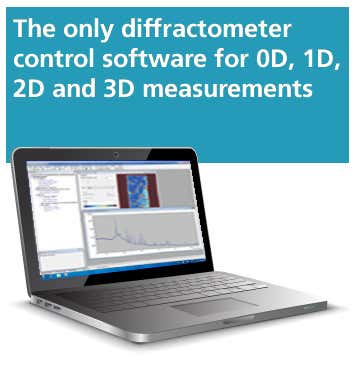Features
One consistent workflow for 0D, 1D, 2D and 3D measurements
The Malvern Panalytical Empyrean, X’Pert³ MRD (XL) and X’Pert³ Powder platforms provide a range of applications such as phase identification and quantification, small- and wide-angle X-ray scattering, pair distribution function, computed tomography and various thin film analysis techniques. Data Collector provides a logical, unambiguous, single workflow for all these applications. Switching from point or line detector applications to area detector measurements does not require the execution of different data acquisition software packages; it can all be done within Data Collector.
 搭配 OmniTrust 使用:Malvern Panalytical 為受管制環境而生的合規性解決方案
搭配 OmniTrust 使用:Malvern Panalytical 為受管制環境而生的合規性解決方案
Easy experiment setup and execution
Data Collector contains advanced features to help set up the right experiment to produce the right results. Data Collector contains a library of predefined measurement routines for theta-2theta scans, 2theta only scans as well as omega-2theta scans. Sample positioning is also handled conveniently, whether it is phi, chi, X, Y or Z: they can easily be programmed and automatically be optimized by Data Collector.
Also setting up measurement routines containing various X-ray diffraction scans in combination with sample positioning and optimization can be done conveniently with Data Collector's batch programming capabilities. It includes automatic control of the temperature for in situ XRD experiments, and automatic sample height compensation. When changing from one experimental setup to another, Data Collector wizards guide you through that process. Data Collector also features automatic validation of the experimental setup.
Open XML file formats
Storing raw measurement data together with all measurement parameters is of the utmost importance. XRDML files that are written by Data Collector make this possible by using the open XML format. XRDML files guarantee convenient data storage, accessibility and archiving. Users have access to all instrument settings and measurement parameters to repeat the measurement. Also, the XRDML format is fully open enabling user-input routines for analyzing diffraction data. Measurement programs are stored in XRDMP files that also use the open XML format. XRDMP files allow sharing of lengthy measurement programs or safe storage on the company server.
Easy previewing of data with Data Viewer and PANViewer
For a quick display and comparison of measurement data, the Data Viewer program is delivered with Data Collector. With Data Viewer it is easy to preview data before performing the final analysis. Users can scale, shift and compare different data sets. It is also possible to export to other commonly used file formats.
For 2D micro-diffraction and 2D SAXS experiments as well as for computed tomography measurements performed with the PIXcel or PIXcel3D 2x2 the PANViewer program is available. It allows for a quick overview of 2D or CT measurements. PANViewer has also various possibilities to export to commonly used file formats.
Automatic processing program - easy automation of routine tasks
Data Collector also comes with the Automatic Process Program that allows automating routine tasks. For example, users can set up the Automatic Processing Program such that a finished measurement is automatically loaded into HighScore Plus, which then will perform a Rietveld analysis according to the user batch created. Automatic Processing Program works can be used to trigger any software that has a command line interface, such as Malvern Panalytical’s wide variety of analysis programs.
Operator Interface – simplifying complex measurements
The Operator Interface is an optional module that allows users (production control operators, analysts or researchers) to graphically create a measurement job that can contain information on how to measure samples as well as on how to analyze them after the measurement.The job is executed via Data Collector on a Malvern Panalytical X’Pert³ Powder, X’Pert³ MRD or MRD XL and Empyrean diffractometer system, either equipped with a high-throughput stage, a sample spinner with a sample changer or an MRD XL cradle with a cassette wafer loader. The Operator Interface supports cassette-to-cassette operation, flexible wafer or well plate mapping as well as using the sample table as sample changer.
XRDML
You own your data
Malvern Panalytical’s philosophy is that our users can do with their XRD measurement data whatever they want. Therefore, all data that are measured with Malvern Panalytical’s XRD instruments are stored in the open XRDML file format. This file format is XML based and stores XRD measurement data in a human readable format along with all information required to reproduce the data. Users can now create their own routines in data processing programs, such as Matlab.
XML schema
The XRDML schema is under continuous development to follow the latest additions to the Malvern Panalytical XRD product portfolio. In order to be compatible with the latest XRDML schemes and to benefit from the latest features, the most recent XRDML schema version is available.
Detailed documentation about the data structure is available for those users that want to create their own routines that read XRDML files.
Useful links
www.w3.org
www.w3.org/XML
www.w3.org/XML/Schema
www.xmlspy.com
Malvern Panalytical is not responsible for the content of external websites
Note: ownership and copyright of the XRDML schema lies exclusively with Malvern Panalytical, as well as the right to make successor or derivate versions of the schema. However, Malvern Panalytical takes no responsibility for any disadvantages or damages caused by the use of this published schema.
User documentation
This Quick Start Guide helps you to get started with Data Collector quickly. The examples in the guide show you how to use the software to do simple tasks, with examples to help guide you.
Download the Quick Start Guide (ED14)
規格
Maximum compatibility
Data Collector writes diffraction results in XRDML files that also include information about the measurement setup. XRDML files are compatible with all Malvern Panalytical XRD software packages. Computed tomography data is stored in TIFF files that are compatible with most image-viewing or processing programs. Experimental parameters are written in VGL files that are compatible with VolumeGraphics’ VGStudio MAX version 3.0.
Recommended system configuration:
Designed for and running on Windows 8.1 (64-bit) and Windows 10 (64-bit) Current Branch for Business operating systems.
A PC configuration matching the (minimum) hardware requirements for the desired Windows operation system will be sufficient.
| 当前版本 | 7.1 |
|---|

